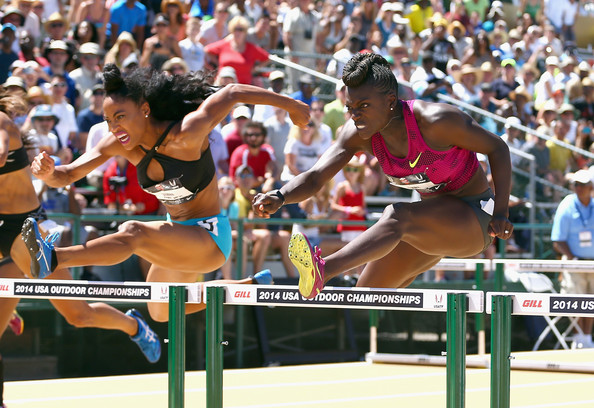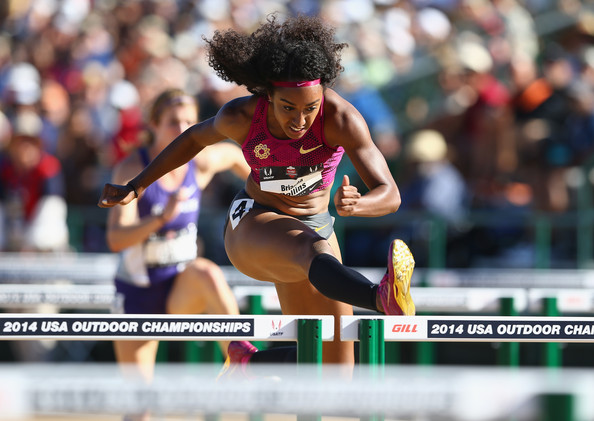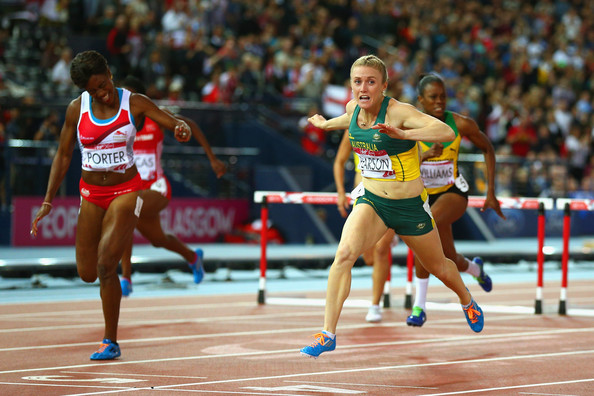The Women’s 100 Meter Hurdles: Harper-Nelson Leads the Way
Last month we took a look back (and look ahead) at the men’s 110 meter high hurdles, and this month we’ll do the same with the women’s 100 meter hurdles. While the women’s race didn’t have as much of an influx of new faces as the men’s race, there was no shortage of intrigue. Despite 2014 being a down year in terms of major world championships, the competition was hot all summer long, particularly in the diamond league meets. So let’s take a look at how things played out and what we might expect heading into 2015.
All discussions of the women’s 100 meter hurdles must begin and end with Dawn Harper-Nelson. That’s arguably been the case for several years now, although she has been overshadowed by other stars, most notably Sally Pearson and Brianna Rollins. But if you think about it, no female hurdler has been as good as consistently as Harper-Nelson since her Olympic gold medal winning performance in 2008. (Even then, she was overshadowed by Lolo Jones, who “should” have won the gold, and would have had she not fallen over the ninth hurdle, diminishing the legitimacy of Harper-Nelson’s victory in the eyes of many). In the 2012 Olympic Games, she pushed Pearson to the brink, losing by .02, with both of them running exceptionally fast times (12.35-12.37). In 2013, world champion Rollins had a dominant outdoor campaign, defeating all professional competition after destroying her collegiate opponents in the spring.
[am4show not_have=”g5;”]
[/am4show][am4guest]
[/am4guest][am4show have=”g5;”]
But 2014, without a doubt, was Harper-Nelson’s year. Pearson had another relatively subpar year hampered by injury, and Rollins similarly fell off the phenomenal pace that had set her apart from the pack last year. And Kellie Wells – Harper-Nelson’s fellow medalist at the 2011 World Championships – didn’t appear in many meets at all. Meanwhile, Harper-Nelson earned herself the Diamond League Championship, she ran the fastest time of any hurdler in the world (12.44), and she ran five of the top ten fastest times in the world. What most impresses me about Harper-Nelson is how much her technique has improved since losing to Pearson at the 2012 Games. Her lead leg is much more efficient, as is her lead arm. The leg stays bent at the knee now and gets back on the ground faster, and the arm cycles in a tight range of motion, helping her to accelerate off of hurdles.
Harper-Nelson’s main rival this year was not Pearson or Rollins, but former collegiate double hurdler extraordinaire Queen Harrison. Harrison has settled in on the shorter race, and had a huge year in 2014. She and Harper-Nelson battled it out for national and Diamond League supremacy throughout the summer, with Harrison narrowly missing out on victory in both cases. At the USA Outdoor Championships in June, Harper-Nelson escaped with a .02 victory, 12.54-12.56, which was actually much faster when considering they were running into a 1.6 headwind. In what I would argue to be the most thrilling race of the outdoor season, Harper-Nelson and Harrison finished 1-2 in Paris in July, 12.44-12.46. Like Harper-Nelson, Harrison is sound technically, very fast between the hurdles, and rarely makes mistakes.

Harrison (left) and Harper-Nelson race side by side at USA Outdoors. Harper-Nelson won by .02. (Note also that her trail arm is a lot tighter than Queen’s).
As for Rollins, many observers assumed, after she broke the American record of 12.26 and won the World Championship in 12.44 in 2013, she was the new golden girl of the hurdles. But the hurdles aren’t the sprints. It’s harder to stay at the top simply because there are hurdles in your way. Also, 2014 was Rollins’ first full year as a professional. Like a lot of track athletes who grow accustomed to racing themselves into shape as collegians, it could be argued that Rollins struggled to adapt to the professional schedule that includes very few races in the spring. Still, she had a very strong season, highlighted by a season’s best of 12.53 in Rome in September, defeating both Harper-Nelson (by .01) and Harrison.
Meanwhile, Pearson started the season off slowly, racing infrequently as she cautiously returned from injury. She managed a season’s best of 12.59, but never proved to be a serious threat to the likes of Harper-Nelson and Harrison. It’s hard to tell where Pearson stands now. She’s still young enough (28) to be a serious contender the next two years. But she has yet to recapture the magic of her 2011 and 2012 campaigns. She switched coaches after 2012, and though from all reports it seems that the change was necessary, since she and her coach just weren’t getting along anymore, you would still have to think that making changes to a successful formula can lead to struggles (think Jeremy Wariner after he left Clyde Hart; he hasn’t been the same since).
Other notables of 2014 would include Tiffany Porter of Great Britain, whose 12.51 in Marrakech (right behind Harper-Nelson’s 12.47) made her the third-fastest female hurdler in the world this year. Lolo Jones, who turned 32 in August, had another fine season, finishing 3rd at USA’s and running a season’s best 12.55 in the semis. Cindy Billaud of France also had a good season. She finished 4th in Paris in 12.71, 4th in Rome in 12.69, and had a season’s best of 12.56 in a preliminary heat in Reims. Kristi Castlin is another to look out for, as her 12.58 victory at the Drake Relays in late April made her the seventh-fastest female hurdler in the world this year.
As for youngsters on the come-up, look out for NCAA champion Sharika Nelvis and 2014 collegians Jasmine Stowers, Brigitte Owens, and Kendra Harrison. All of these women are poised to challenge the older, more battle-tested hurdlers discussed above. I also wouldn’t be surprised to see hurdler/heptathlete Kendell Williams of the University of Georgia take a big step forward, although she might devote her energies to trying to make the World Championship team in the heptathlon.
I think 2015 will be a riveting year in the women’s 100 meter hurdles. All of the ladies mentioned in this article will be primed and ready to go. As for the USA, the scenario is much different than it is in the men’s race, where the best guys are getting older while a new crop of fresh foreign faces threatens to take over supremacy. In the women’s race, the Americans are coming off an outstanding 2014, and show no signs of slowing down. If anything, the old heads and the young whippersnappers are looking so strong that there’s no way of saying who will make the USA team. Harper-Nelson and Harrison seem to be locks right now, but a lot can change between now and June.
As for the larger world scene, expect Pearson to be back at her best, expect Porter to contend for a medal, and Billaud should be in the mix. I’m sure there are hurdlers out there I haven’t mentioned who will rise to the surface and make a big push. We’ll wait and see how things go, but one thing we know for sure is that the women’s 100 hurdles will continue to be one of the most exciting, dynamic events in track and field.
[/am4show]


